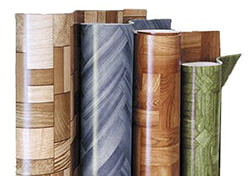 What is linoleum? It is a material obtained by applying a special resin-like compound onto a fabric backing. It can be natural - jute fibers are impregnated with oxidized linseed oil, to which pine resin and wood chips are added. But such linoleum is very expensive, so linoleum coated with artificial polymers, for example, polyvinyl chloride, is more common in everyday life. It is very practical, but at the same time, it can quickly lose its attractiveness if you do not clean it from dust and dirt in time.
What is linoleum? It is a material obtained by applying a special resin-like compound onto a fabric backing. It can be natural - jute fibers are impregnated with oxidized linseed oil, to which pine resin and wood chips are added. But such linoleum is very expensive, so linoleum coated with artificial polymers, for example, polyvinyl chloride, is more common in everyday life. It is very practical, but at the same time, it can quickly lose its attractiveness if you do not clean it from dust and dirt in time.
How to care for linoleum? First of all, after the floor covering is laid and the repair is completed, it is necessary to thoroughly wash it from construction dust and cover it with a suitable protective agent. In the future, to care and maintain a presentable appearance as it gets dirty, linoleum should be washed with warm water and mild detergents.
Linoleum care rules
The rules for caring for linoleum of any kind are almost the same, and consist of several mandatory points:
- Aggressive cleaning agents should not be used when cleaning linoleum floors, as they can damage the coating;
- Caustic soda and other alkalis can corrode the linoleum base;
- Hot water can make the linoleum surface matte;
- If substances containing coloring pigments get on the floor, they must be removed immediately in order to avoid the absorption of pigments into the surface layer and the appearance of colored heels on the linoleum.
However, natural linoleum and materials obtained with the use of synthetic polymers have differences that must be taken into account when leaving, if you want the floors to retain their gloss and attractive appearance for a long time:
- Natural. So that this strong and durable material does not lose its appearance as long as possible, after laying it is thoroughly cleaned of construction debris using dry and wet cleaning. Then, after letting it dry completely, apply protective mastic compounds, which are carefully polished. Depending on how "passable" the room is, the floors are re-treated with mastic two to four times a year, renewing the protective coating.
- Artificial. Polymeric substances, in particular, polyvinyl chloride (PVC), are used as substitutes for thickened linseed oil with fillers from natural components in the production of linoleum. This significantly reduces the cost of production and, accordingly, the product. PVC coating can be homogeneous - in which case it is quite thick, and heterogeneous - with a thin top decorative layer. The latter needs special care, since the thin layer is easily broken and loses its appearance. Cleaning such floors using solvents (acetone, white spirit, kerosene) is prohibited.
Removing stains when cleaning linoleum
In the event that you did not notice the pollution in time, and a stain has formed on the linoleum, it should be removed taking into account the specifics:
- Coffee, food coloring: drip a few drops of kerosene or gasoline onto a clean, dry cloth and gently rub the stain. If the dye gets on natural linoleum, you can gently rub it with a piece of "zero" skin (with the smallest "grain" size, then wipe it with a damp cloth, let it dry and grease with linseed oil;
- Iodine: Iodine stains may gradually disappear on their own, but it is better to try to remove them by sprinkling a little baking soda on a damp cloth and rubbing gently. After this cleaning, the linoleum must be well rinsed and rubbed with polish.
- Zelenka: Dab some camphor rubbing alcohol on a cotton swab and scrub the stain. Change the cotton wool as it gets dirty.
- Mold, rust: cleaning linoleum from these contaminants is carried out using hydrogen peroxide, diluted with water in a ratio of 1 to 10. You can also use bleach for washing clothes, also diluting it in water. Then rub the surface well with lemon juice.
- Fat: grease contamination is washed off with a solution of mild detergents, having previously blotted with a paper towel.
Linoleum cleaning: materials, tools, work procedure
To care for your linoleum floor you will need the following materials:
- A mild detergent that does not contain acids, alkalis or abrasives;
- Warm water;
- Protective coating (polish) for final care.

Of instruments to clean linoleum you need:
- Bucket;
- Floor brush,
- Doormat;
- A vacuum cleaner;
- Cleaning wipes.
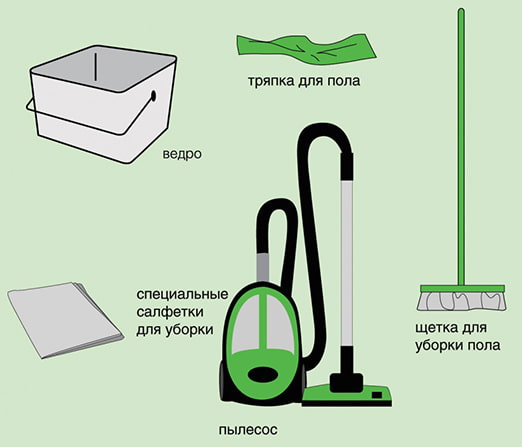
Work order
Cleaning can be divided into three main steps. Let's consider them one by one.
1
Cleaning from dirt
Cleaning begins with dry cleaning of linoleum, which removes debris and dust. This is done with a brush and vacuum cleaner. After that, you need to inspect the floors for stains. If they are, withdraw them using suitable means.
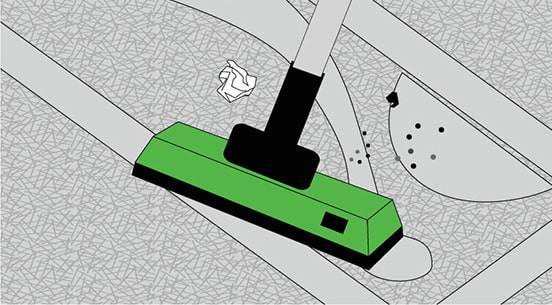
After that, you can start wet cleaning.
- Pour warm water into the bucket, add a mild detergent, stir;
- Wet a rag and wring it out well;
- Wipe the linoleum with a damp cloth;
- After finishing wet cleaning, wipe the linoleum with a dry cloth.
Important: Do not add ammonia, soda to the water, do not use various solvents for cleaning stains - they can worsen the appearance and performance of linoleum.
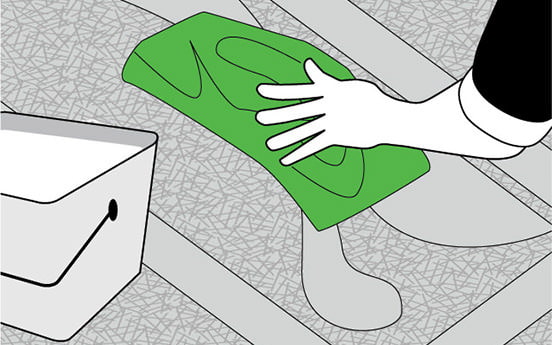
2
Polishing
To make linoleum shine, it is polished with special means. Choose a polish according to the material of the floor covering.

3
Protection
Preventive measures are the best way to preserve your flooring for years to come. Linoleum is exposed to both mechanical stress and the action of various, often aggressive environments. Therefore, preventive measures can also be divided into two groups:
- Mechanical: Furniture legs should be smooth so as not to scratch the linoleum. Make felt heels on them, or put on special covers. An ordinary hard rug near the front door, or a lattice rug, will help to qualitatively clean shoes from street sand, which, being brought into an apartment, acts on linoleum as an abrasive, depriving it of its shine and attractiveness.
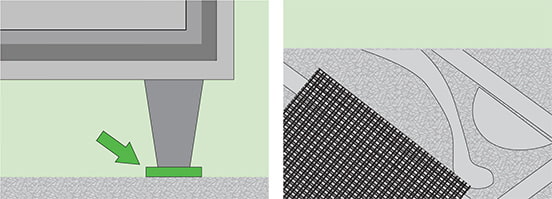
- Chemical: At the final stage of cleaning linoleum, you can apply a protective layer to the flooring. It can be a variety of polishing compounds and emulsions. They create a protective film on the treated surface that insulates the material from external influences. The protective layer will reduce the adhesive properties of linoleum, it will get less dirty and absorb dirt. This facilitates the maintenance of linoleum, increases its resistance to abrasion and scratches, imparts water-repellent properties, and significantly extends its service life.
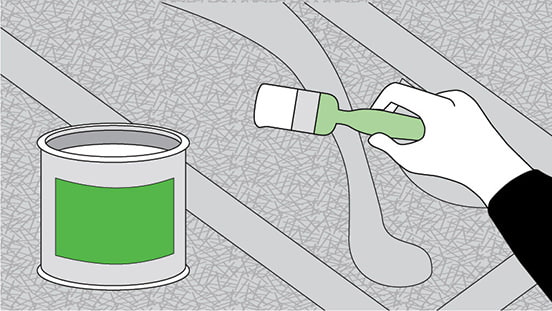
Advice: To extend the life of your flooring, comply with the operating conditions. Avoid negative factors that negatively affect linoleum. These include:
- Ultraviolet (direct rays of the sun);
- Mold and mildew (formed when water enters the joints of the canvases);
- Temperature drops;
- Open fire;
- Piercing and cutting surfaces.


 10 practical tips for arranging a small kitchen in the country
10 practical tips for arranging a small kitchen in the country
 12 simple ideas for a small garden that will make it visually spacious
12 simple ideas for a small garden that will make it visually spacious
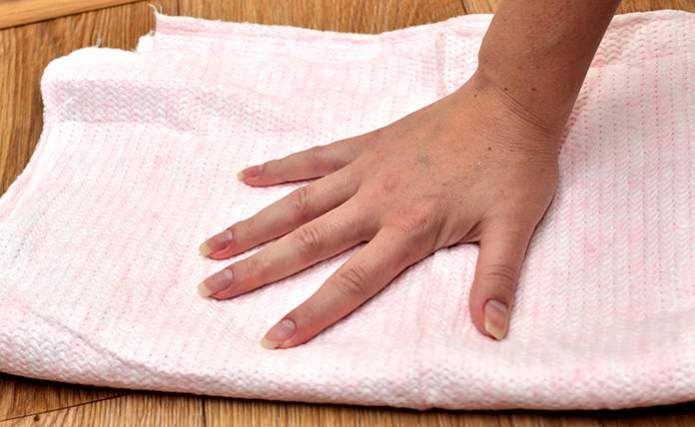
 13 bad habits a good housewife shouldn't have
13 bad habits a good housewife shouldn't have 24/7 home cleanliness - 4 secrets for the perfect housewife
24/7 home cleanliness - 4 secrets for the perfect housewife 6 hotels in Sochi that will give odds to the promoted foreign hotels
6 hotels in Sochi that will give odds to the promoted foreign hotels Top 10 interior design trends 2020
Top 10 interior design trends 2020 Rating of cheap TVs with Smart-TV
Rating of cheap TVs with Smart-TV New Year's LED garlands on AliExpress - we disassemble while it's hot, so that it's bright at home
New Year's LED garlands on AliExpress - we disassemble while it's hot, so that it's bright at home